Abstract
The article contains the results of the first part of the research on the analysis of the operation of the retention device cooperating with the drainage system—steerable detention tank and concerns model simulation studies. The obtained results are an introduction to conducting laboratory tests. The planned research was carried out on the basis of the theory of experimental planning and hydrodynamic modelling, in which the systems of hydraulic parameters of the drainage system and hydrological of the catchment were selected. In total, over a thousand hydrodynamic simulations were carried out using SWMM 5.1. The planned analyses had two main goals. Firstly, to verify the possibility of reducing the rainwater volume flow in the drainage system by means of controllable devices enabling cooperation with the drainage system in various hydraulic conditions of the drainage system. Secondly, determining the impact of the connection method (parallel or serial) of the device enabling retention and cooperation with the sewage system on the efficiency of the system. The conducted analyses showed that the use of a retention device cooperating with the drainage system may significantly reduce the amount of sewage outfall from system, depending on the capacity of a single micro-accumulator, even up to 83% (in the analysed data range). It was also shown that the method of connecting the device to the network has an influence on the efficiency of the system in depend on hydraulic conditions.
1. Introduction
The most common problem in recent decades in urban hydrology is the increase in the amount of rainwater directed to drainage systems, which results in the malfunctioning of the city’s drainage infrastructure. The most frequently indicated factors affecting the current state of urban water management include the increasing frequency of extreme rainfall events [1,2,3], depletion of biologically active areas [4,5], waste of rainwater potential [6,7] or even the nonprospective development of urban agglomerations [8,9]. As a consequence, this leads to a disturbance of the natural water circulation in nature, resulting in an increase in rainwater runoff, leading to urban floods and droughts is a significant and important problem. This is confirmed by numerous studies, including [10]. The significance of the problem is also confirmed by legislative measures, such as the planned fees for the discharge of rainwater into the drainage system.
The issue of climate change is also important here, as it directly affects the amount of rainfall and its nature, which often has to be taken into account in hydrodynamic modelling of drainage systems [11,12].
Research and scientific work conducted in this area focus on two important aspects. The first is to try to solve the problem at its root in terms of limiting the amount of rainwater directed to the drainage system, among which the most frequently used term in research is the ideology of SpongeCity, LID (Low Impact Development) [13,14,15]. In their work, Zevenbergen et al. [13] noted that an inherent element of rainwater management systems in their country is monitoring the current conditions. They indicated that to a large extent it could be implemented with the use of IoT (Internet of Things). This confirms the assumptions of the authors of this study on the inclusion of IoT in the tested solution.
On the other hand, Meng et al. [14] pointed to the significant advantages of introducing the sponge city ideology. In their research, they introduced a project which, in order to enforce the use of LID facilities and their proper design, involves designing the sewage network only for a capacity close to 40% of the amount of rainwater from rainfall. Such an approach confirms the necessity to implement solutions for collecting excess water in the case of extreme phenomena, and these include the device tested in this framework. On the other hand, the second is the search for ad hoc solutions to prevent the negative effects of emerging irregularities, among which the problem of rainwater retention is the most frequently discussed. In their research, Drumond et al. [16] conducted a survey that showed that greater knowledge of city storm water did not correspond to greater desire among stakeholders to manage them. However, overall, respondents said that they had benefited from using the local system for this water detention, and that willingness to use this system was related to their socioeconomic class and level of wealth.
In other studies Drumond et al. [17], they conducted research on the water flow characteristics in an urban system in which on-site reservoirs were used. They showed that the analyses based on the common rational method differ significantly from the real flows in systems containing this type of devices. This indicates the need to develop digital models of individual solutions consistent with the generally available software for hydrodynamic modelling of drainage systems.
As part of the research on specific technical solutions, Ngu et al. [18] conducted research on the use of orifices choking the outflow from the outflow of on-site reservoirs. They showed that the use of properly designed orifices significantly reduces the flow in the system. Their conclusions were used in this study. The thesis was verified in relation to the solution proposed in this article.
On the other hand, Rodney et al. [19] undertook to verify the effectiveness of the operation of on-site tanks in the actual conditions of their operation in an annual cycle. They pointed out that due to the way they are designed based on a specific rainfall event, the assumptions of its operation may turn out to be incorrect in the annual cycle. Especially when considering precipitation events occurring one after the other. It was a valuable observation because it directed the authors of this study to pay attention to the need to implement machine algorithms in the work of the tested solution.
An inseparable element of the functioning of specific technical solutions was the economic research conducted by Bonane et al. [20], not only in the financial but also social field. Their research revealed that not only in the financial but also social field not always a solution aiming at greater economy for the micro level (that is, the subdivision) is the most appropriate in terms of the environment, public health, welfare and social responsibility.
In terms of research on similar solutions, the works of di Matteo [21] can be distinguished, which proposed an on-site solution for tanks cooperating with the automation system, the operation of which was regulated by filling sensors located in the chambers. Their task was to control the method of emptying the tank on site. Contrary to the solution presented in the research, however, they did not provide for two-way cooperation with the drainage network, as is the case in the solution presented in this paper. On the other hand, in the Pochwat study [22], the object of research was also solutions that were supposed to improve the functioning of sewage systems by transforming their hydraulic system. In these studies, an attempt was made to introduce efficiency coefficients that would be able to easily assess the effectiveness of individual solutions. The introduced effectiveness coefficients were based on the least hydraulically effective solutions (single-chamber tanks). Particular attention is focused here on the solution of a modified multi-chamber reservoir, the structure and design of which are described in the paper [23]. On the other hand, the work [24] indicates significant difficulties with the implementation of non-typical solutions for hydraulic systems of detention facilities due to the lack of appropriate design methodologies.
The most important action is to solve the problem at the root of its creation, but in many cases, solutions related to the SpongeCity ideology are very difficult to implement in highly developed urban agglomerations. For this reason, this paper focuses on research aimed at the application of ad hoc solutions that can be applied if the problem already exists to a large extent and it is necessary to bring the system to a proper functioning situation. That will constitute the basis for a further restrictive water management policy based on rational drainage of rainwater and mainly their use. An ad hoc solution to the problem may be the use of advanced steerable underground tank, whose task will be not only to collect the water generated at the place where they are created, but above all to actively cooperate with the drainage system.
Taking into account the problems presented, this research sets two main research goals:
- verify the possibility of reducing the rainwater volume flow in the drainage system by means of controllable devices enabling cooperation with the drainage system in various hydraulic conditions of the drainage system.
- determining the impact of the connection method (parallel or serial) of the device enabling retention and cooperation with the sewage system on the efficiency of the system.
The obtained test results are the basis for further research on the real model of the device in laboratory conditions.
2. Materials and Methods
2.1. Tested Device
The tested device is shown in Figure 1. This detention tank device is not a conventional underground tank. First of all, the bottom of the inlet pipe is on the same level as the city drainage conduit. Secondly, on the inlet pipe, there is an electro valve, which controls the operation of the device, allowing for the outflow, closure, or inflow of rainwater. Thirdly, the system is controlled by a Programmable Logic Controller (PLC) driver with an algorithm written in Totally Integrated Automation Portal (TIA). The device under test in the actual application shows the possibility of connecting two devices using the access for the development of private land.
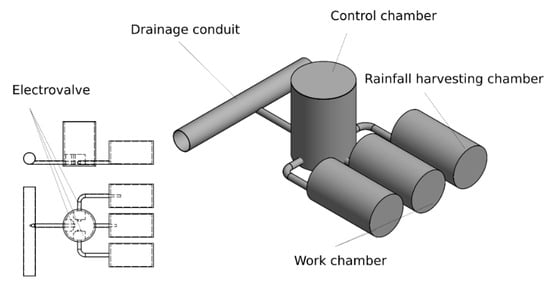
Figure 1.
Model of a steerable underground tank for sewage systems (control system with the driver not visible).
As shown in Figure 2, the length of the working chambers and the direction of their leading can be freely adapted to local conditions in order to use the free space under the ground as much as possible. The steerable underground tank shown in Figure 1 and Figure 2 was constructed and prepared for laboratory testing.
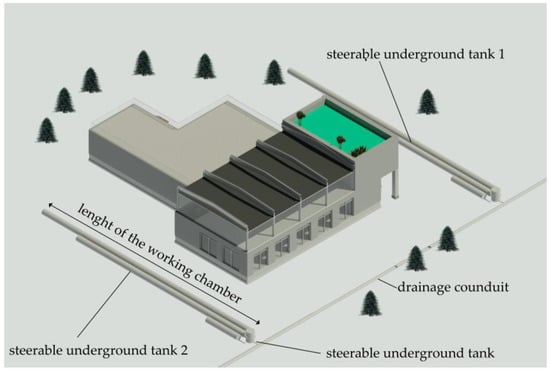
Figure 2.
An example of the solution’s implementation.
Figure 3 describes the individual elements of the device on the prepared prototype. In the tank chamber and on the drainage pipe, there are installed ultrasonic sensors, which send the information to the PLC driver.
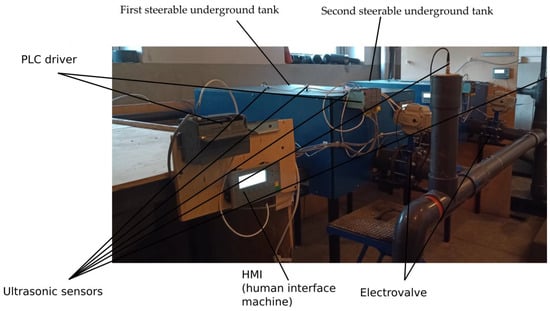
Figure 3.
Photograph of the device in laboratory conditions.
The idea behind the solution is to enable the network to cooperate with the tanks installed on private properties. The hydraulics of this steerable underground tank makes it possible not to differentiate the levels of the bottom of the network and reservoirs. This approach will allow the tank to be filled and emptied without pumping equipment and will increase the channel retention of the system. At the same time, research is planned to introduce the possibility of leasing the capacity of reservoirs installed on private properties for the operators of drainage networks (similar to PV panels). If there is no space in the city for modernization of the drainage system, for example due to lack of space, an individual investor, for example an owner of a home or a hypermarket, could install such tanks on their premises and “rent their retention capacity”. The creation of such a possibility and the carrying out of broader economic analyses will be the subject of further research.
Other important features of the device include the possibility to control the device’s (steerable underground tank) operation by means of a digital network in a forced, automatic manner, also with the possibility of using prediction algorithms. This is performed by a PLC controller, which also allows the device to be connected to the Internet of Things. This approach allows one to monitor the transfer and collection of the data from the device. The device’s measurement capabilities, combined with innovations in data management and participation in the Internet of Things (IOT), provide a unique opportunity to connect a large number of information-generating nodes (be it devices or people) to the process of gathering relevant information. Especially in the field of water management, these changes should be permanently adopted in the processes of water systems’ management. The implemented control algorithm enables the proper operation of the device in various hydraulic conditions. The device has also been prepared for the implementation of an artificial neural network responsible for its operation, which is also a research topic for development. Figure 4 shows a hydraulic section through the device.
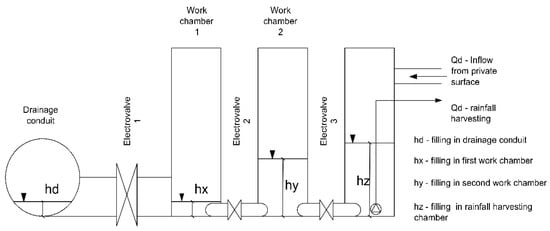
Figure 4.
Illustrating characteristic fillings in individual sections of the device.
2.2. Methods
The research was based on analyses carried out on the basis of the numerical analyses of the functioning of various configurations of drainage systems [25]. Digital simulations were carried out with the use of the SWMM software. The methodological basis for the functioning of the software (including SWMM 5.1.) is the de Saint-Venant system of equations, which enables the determination of characteristic flows and filling in individual sections of the system. The equations are shown in Equations (1) and (2) [26].
Here, S0 is the riverbed gradient, y is the water depth, A is the cross-section area, g is the gravitational acceleration, x is the longitudinal distance, v is the flow velocity, and t is time. Equation (1) is the continuity equation, and Equation (2) is the momentum equation. The basis for the simulation was the preparation of an appropriate number of models of drainage systems characterized by different hydraulic parameters of the system and hydrological catchment area. This was performed using the Design Of Experiments (DOE). Based on the literature reports, the parameters that should be taken into account were reviewed. Then, using the Statistica software, an appropriate plan of experiments was prepared, indicating the necessary number of hydraulic/hydrological parameter systems and the range of their values.
The implementation of this part of the research was based on the DOE, because the performance of the complete research, the analysis of every possible variation of the variable parameters of the catchment area, is unreasonable. The number of catchment configurations so obtained, necessary for testing, would be almost unlimited. On the basis of the developed research plan, appropriate models were made in the SWMM program environment. Then, each obtained model of the system was loaded with rainfall (time-varying rainfall was obtained by transforming the Intensity Duration Frequency (IDF) curves in accordance with the Euler procedure for rainfall type II) [27] with different durations of rainfall from 10 min to even 30 min. The standard hyetogram Euler type II model has a discrete form. This model is based on the assumption that the highest instantaneous precipitation intensity (from the IDF curve) occurs at the end of one-third of its duration. For a five-minute time discretization step, the interval with the highest intensity from the beginning of the IDF curve is located at the end of 1/3 of the model precipitation duration. Subsequent intervals with lower intensity are listed in descending order—to the left of the interval with the highest intensity. The other interval intensities are also ranked in descending order, to the right of the interval with the highest intensity, until the end of the precipitation time is reached. An example of a transformation is shown in Figure 5.
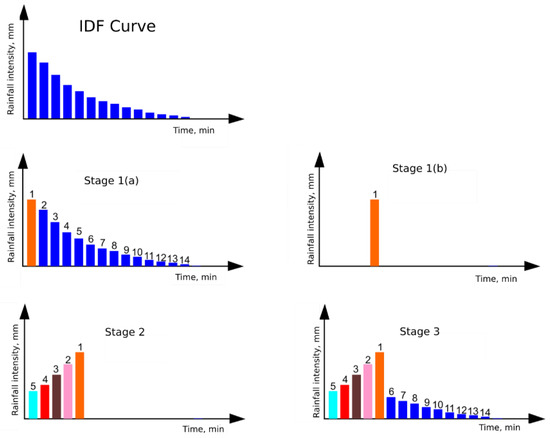
Figure 5.
Example of the transformation of the IDF curve to Euler type II rainfall.
The aim of these studies was to determine the critical duration of rainfall in order to determine the most unfavourable hydraulic conditions in the drainage system, i.e., those that will generate the highest flow in the drainage system.
2.3. Key Study
In each of the analysed variants, a sewage system was considered with the geometry shown in Figure 6, the hydraulic and hydrological parameters of which were changed in accordance with the developed research plan presented in Table 1. The most important difference should include the reference to the catchment area in variant WA, referring to the entire system in ha, in turn in variants WB and WC with regard to a single partial catchment, expressed in ha*10−2.
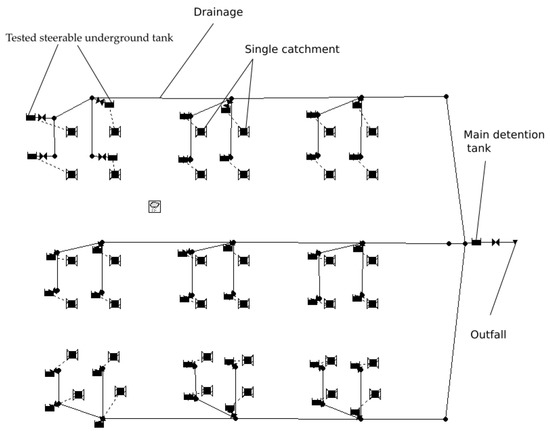
Figure 6.
Geometry of the analysed sewage systems.

Table 1.
Acquired test plan with the conversion of code values into real ones.
On the basis of the developed research plan, catchments representative of each variant were built. Each test plan (27 systems) was tested for 3 different flow reduction factors B (0.35 0.5 0.65) and for different steerable underground tank surfaces (1 m2, 2 m2, 3 m2, 4 m2, 10 m2). In total, for the WA variant, 486 hydraulically different catchments were built, for the WB-486 variant, for the WC-386 variant, and for the W_Flodding-324 variant:
- Description of the WA variant:
The WA variant was characterized by connecting the working chamber of the micro-accumulator directly to the drained partial catchment, which means that the nature of its operation can be described as flow-through. The catchment areas presented in the research plan refer to the entire sewage system and are expressed in hectares. The system cooperates with a central network retention reservoir, as shown in Figure 6. An example of connecting the analysed battery to the drained catchment is shown in Figure 7a.
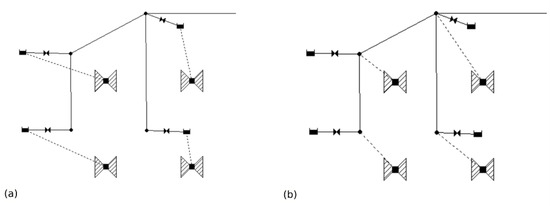
Figure 7.
Connection of the working chamber of the steerable underground tank (a—in the WA and WB variants, b—in the WC variant).
- Description of the WB variant:
The WB variant was characterized by connecting the working chamber of the micro-accumulator directly to the drained partial catchment, which means that the nature of its operation can be described as flow-through. The catchment areas listed in the research plan refer to a single partial catchment area and are expressed in ha*10−2. Connecting the analysed underground tank to the drained catchment is the same as in the WA variant (Figure 7a).
The system cooperates with a central network retention reservoir, as shown in Figure 6. Compared to the WA variant, this is characterized by a generally smaller sealed area of the catchment and reflects the use of the solution in the scale of a residential area of single-family houses.
- Description of the WC variant:
The WC variant was characterized by the connection of the micro-accumulator working chamber to the side of the drainage network, which means that the nature of its operation can be described as parallel. The catchment areas listed in the research plan refer to a single partial catchment area and are expressed in ha*10−2. An example of connecting the analysed accumulator to the drained catchment is shown in Figure 7b. The system cooperates with a central network retention reservoir, as shown in Figure 6. Compared to the WB variant, this one is characterized by identical hydraulic conditions, including the catchment area, and the difference is in the connection of the accumulator. As part of the research, a number of hydrodynamic simulations were carried out with the use of the SWMM 5.1 software, version 5.1.012. As part of the simulation, the catchment area was loaded with critical precipitation. As a result of the research, hydrographs of rainwater flow were obtained. The data obtained in this way constituted the basis for further analyses.
Analysis plan:
- Analysis of the quantitative reduction of wastewater leakage from the system thanks to the application of the solution in question;
- Analysis of the possibility of reducing the maximum flow rate of sewage at the final node of the drainage system;
- Analysis of the limitation of the capacity of the main tank in cooperation with the solution in question.
3. Result and Discussion
3.1. Analysis of the Quantitative Reduction of Wastewater Discharge from the System Thanks to the Application of the Solution in Question
In the first step, the possible limitation of the amount of wastewater that occurs in the system during the insufficient capacity of the drainage network was analysed. For this purpose, the results of the amount of sewage discharged from the system in two variants were compared. The first concerned the classic system, and the second concerned the system equipped with steerable underground tanks.
As a result, four groups of results were created:
- Results of the overflow of wastewater from the system in the absence of the introduction of the steerable underground tank for sewage systems.
- The results of wastewater spillage from the system using the steerable underground tank for sewage systems, with a working chamber area of 2 m2.
- The results of wastewater spillage from the system using the steerable underground tank for sewage systems, with a working chamber area of 4 m2.
- The results of wastewater spillage from the system using the steerable underground tank for sewage systems, with a working chamber area of 10 m2.
The assessment was carried out on the basis of the simulation results showing the amount of discharged sewage from the system for models of sewage systems characterized by different hydraulic and hydrological parameters and a different degree of reduction of the flow of rainwater transported (0.35 to 0.65). In order to interpret the results, the G parameter was introduced, described by Equation (3), which describes the ratio of the difference in the amount of wastewater poured out in the absence of the steerable underground tank (Vf(A0)) and the amount of wastewater poured out with the use of the tanks (Vf(Ai)) with the surface i to the amount of wastewater poured out in the absence of the analysed solution.
Figure 8 shows the results of the analysis for the area of the working chamber of 2 m2, while Table 2 summarizes the highest and the lowest G parameters. The parameters of the drainage system resulted in a reduction of the amount of discharged sewage from 0 to 40%. The 0 value on the diagram indicates that there is no leakage of wastewater, whether or not the device under test is used. Thus, the average values were calculated from the events in which the rainwater overflowed from the drainage system. The greatest reductions were obtained with the greatest degree of flow reduction at the level of 0.65 (systems from 55 to 81). The smallest reduction was obtained with the smallest degree of sewage flow reduction equal to 0.35 (systems from 1 to 27). The description of the hydraulic/hydrologic parameters for each data chip number of the catchment are attached in Supplementary S1.
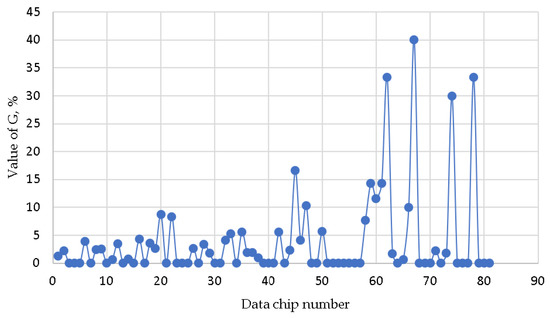
Figure 8.
The results of the analysis of the G parameters for the area of 2 m2 steerable underground tank chambers.

Table 2.
The maximum and minimum values of the G parameter (for the area of 2 m2).
Similar tests were carried out with the working chamber area of the battery equal to 4 m2. The results of the analyses are shown in Figure 9, and the smallest and highest values of the amount of reduction of discharged rainwater are summarized in Table 3. In this case, a greater maximum possible reduction of the amount of discharged sewage was obtained, ranging between 0% and 67%. Similar to the area of 2 m2 of the working chamber of the battery, the best results were also obtained for the largest reduction ratio of 0.65, that is when it is necessary to reduce the flow at the end node as much as possible. Higher percentages of flow reduction, up to 67%, due to the larger surfaces of the working chambers, i.e., the relatively higher battery capacity, are obvious.
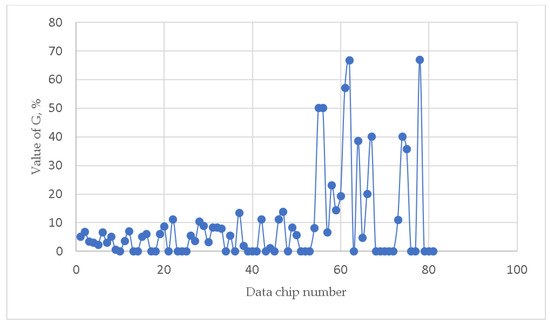
Figure 9.
The results of the analysis of the G parameters for the area of 4 m2 steerable underground tank chambers.

Table 3.
The maximum and minimum values of the G parameter (for the area of 4 m2).
Similar results were obtained with the working chamber capacity of 10 m2. The results of these analyses are shown in Figure 10, and the smallest and largest values of the flow reduction are in Table 4. In this case, an even greater maximum possible reduction of the amount of wastewater poured out was obtained, ranging between 0% and 83%. Similar to the area of 2 m2 and 4 m2 of the battery working chamber, the best results were also obtained here for the largest reduction ratio of 0.65, that is when it is necessary to reduce the flow at the end node as much as possible. Higher percentages of flow reduction, up to 67%, due to the larger surfaces of the working chambers, i.e., the relatively higher battery capacity, are obvious.
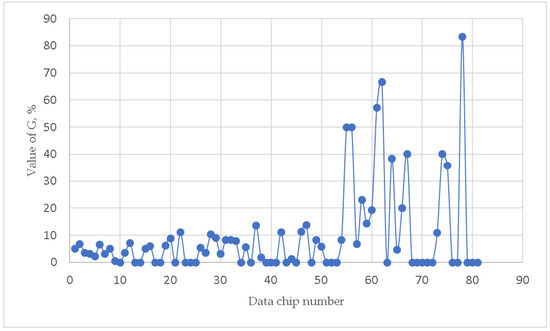
Figure 10.
The results of the analysis of the G parameters for the area of 10 m2 steerable underground tank chambers.

Table 4.
The maximum and minimum values of the G parameter (for the area of 10 m2).
In all cases, a similar trend was observed: the higher the reduction coefficient the system has and thanks to the use of the Intelligent Control System for individual rainwater retention for sewage systems, the greater the (percentage) reduction of the amount of wastewater spilling out of the system. At the same time, the greater capacity of the tank (its projection area) results in a greater reduction of the flow rate. The most spectacular results were obtained for a high level of beta flow reduction of 0.65, reaching 83%. By analysing the smaller reduction of flow necessary to ensure (in the tests 0.35 and 0.5), the use of the solution in question allows for the reduction of the amount of discharged sewage in the range of 0 to 15%. Summing up, it can be stated that the application of the solution in question in an organized drainage system with the assumed degree of flow reduction in the drainage network may significantly reduce the amount of wastewater spilled and the reduction of the volume flow of wastewater, which confirms the assumptions of the operation of the solution.
3.2. Analysis of the Quantitative Reduction of Wastewater Discharge from the System Thanks to the Application of the Solution in Question
The analysis was carried out for identical hydraulic conditions of the catchment area and the sewage system, the WB and WC variants (the WA variant was a variant used to confirm the observed properties). The purpose of this analysis was to determine a possible transformation of the rainwater outflow curve into a curve characterized by a lower degree of the maximum rainwater flow for the two indicated variants. The conducted analysis allowed indicating which of the methods of connecting the Intelligent System for controlling individual rainwater retention for sewage systems in relation to the sewage network and catchment area is more hydraulically advantageous. For the purpose of the assessment, the parameter K (Equation (4)) describing the ratio of the maximum flow of rainwater in the variant connecting the WB solution in question to the maximum flow of rainwater in the variant WC was introduced.
Figure 11 shows the results of the analysis of the K coefficient value, while Table 5 summarizes the highest and the lowest value of the K parameter. The conducted analyses show that when using the Intelligent Control System for individual rainwater retention for sewage systems, regardless of the parameters of the drainage system, it is necessary to connect the solution in question in the WB option, i.e., treating the tank in series. From the results of Table 5, in the most advantageous case, the use of the connection of the solution in question in the WB variant allows for a significant reduction of the flow rate, and the K index is from 0.42 to 0.99. The value of 1 was not exceeded in any case. This shows that, in each of the analysed cases, it is more advantageous to use the WB variant because it allows for a greater reduction of the flow.
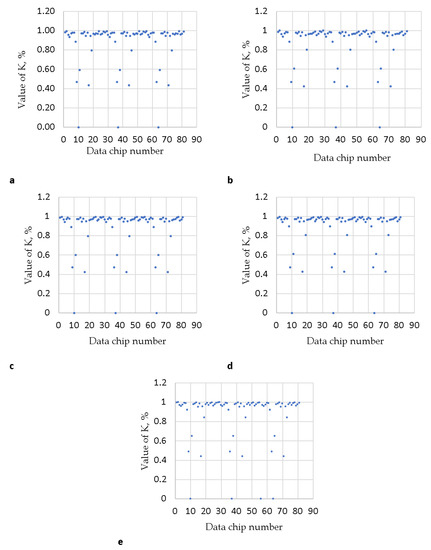
Figure 11.
The results of the value of the K parameter analysis for various areas of steerable underground tank chambers ((a)—1 m2, (b)—2 m2, (c)—3 m2, (d)—4 m2, (e)—10 m2).

Table 5.
The maximum and minimum values of the K parameter.
An exemplary transformation of the rainwater runoff curve at the lowest point of the system is shown in Figure 12 for the WB variant and Figure 13 for the WC variant. Due to the excessive number of results (over 840), the analysis compiled the results for one selected example, Systems 8, 89, 170.251, 331, and 413. The selected systems are characterized by the same hydraulic and hydrological parameters of the catchment area and the same value of the flow reduction coefficient, but they differ with the surface of the tank.
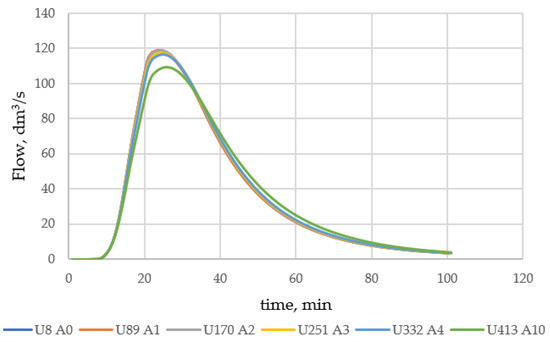
Figure 12.
Outflow hydrograph transformation for Systems 8, 89, 170, 251, 331, and 413 (WB variant) and for the area of steerable underground tank chambers equal to 0 m2 (A0), 1 m2 (A1), 2 m2 (A2), 3 m2 (A3), 4 m2 (A4), and 10 m2 (A10).
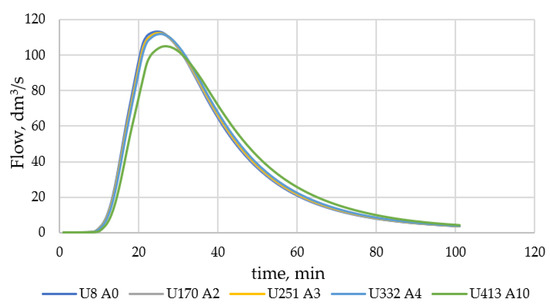
Figure 13.
Outflow hydrograph transformation for Systems 8, 89, 170, 251, 331, and 413 (WC variant) and for the area of steerable underground tank chambers equal to 0 m2 (A0), 1 m2 (A1), 2 m2 (A2), 3 m2 (A3), 4 m2 (A4), and 10 m2 (A10).
Table 6 summarizes the maximum and minimum values of the intensity of rainwater runoff for the analysed variants.

Table 6.
Maximum and minimum values of the intensity of rainwater runoff for the analyzed variants.
3.3. Analysis of the Quantitative Reduction of Wastewater Discharge from the System Thanks to the Application of the Solution in Question
Another analysed aspect is the capacity of the main reservoir shown in Figure 6. In this analysis, its required capacity was taken into account to prevent the possibility of wastewater from overflowing from the drainage system. The simulations carried out in this area allowed assessing to what extent the use of the Intelligent System for controlling individual rainwater retention for sewage systems will allow limiting the capacity of the retention reservoir. The analyses were carried out depending on the type of connection of the solution in question, at the same time taking into account the different surface areas of the working chamber, which ultimately affect its capacity. Conducting this analysis required the determination of the required capacity of the main reservoir in the WB variant and then in the WC variant for each of the analysed systems of the hydraulic and hydrological parameters of the catchment area and the sewage system. The obtained test results are shown in Figure 14. From the presented results, it can be initially estimated that the connection of the solution in question in the WB variant allows for a greater reduction of the required capacity of the main tank than in the WC variant.
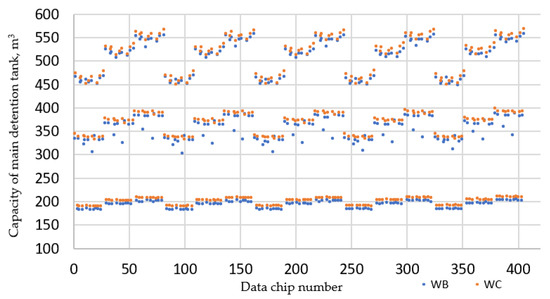
Figure 14.
Required capacity of the main tank for WA and WC variants.
Depending on the number of the system (data chip number of the analysed set of the hydraulic and hydrological parameters of the catchment area and the degree of reduction of rainwater flow in the system), the capacity of the main reservoir for the same rainfall conditions is between 150 and 600 m3. A further evaluation of the individual variants was made in order to determine the difference in the capacity of the main tank ∆V, which is described by Equation (4). The obtained results are shown in Figure 15.
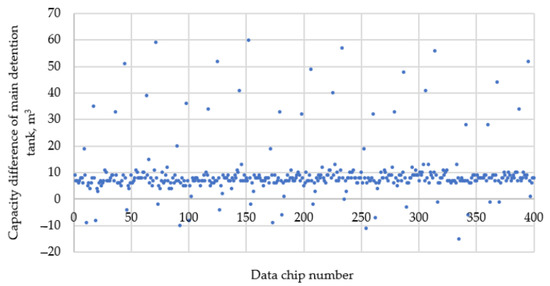
Figure 15.
The influence of the working chamber surfaces of the steerable underground tank for sewage systems on the limitation of the required capacity of the main tank.
The simulations show that not in all hydraulic conditions is it more advantageous to use an intelligent system for controlling individual rainwater retention for sewage systems in the WB variant. In the vast majority of cases (432 analysed systems), positive values were obtained, which indicates the benefits associated with the WB variant. However, there were also systems (92, 100, 127, 154, 181,173, 208, 235, 254, 262, 289, 335, 343, 370) in which negative values were obtained, lacking the greater benefits of using the WC variant. The undertaken research topic in the field of cooperation of micro-accumulators with a drainage network without the use of pumping devices is not a frequent topic of scientific consideration. However, it should be of particular importance when considering improving the functioning of city drainage. Nevertheless, few centres undertake research on similar on-site solutions, which have significant potential in regulating urban water management. The authors of the studies [19] came to similar conclusions and proposed the use of micro-accumulators (on-site). In their considerations, they indicated that the scale of peak flow reduction associated with the use of similar devices increased with the increase in the size of the tank, from 15% to 38% for tanks with a capacity of 1 to 2.5 kL, up to 39% and 48% for tanks with a capacity of 10 kL. However, they analysed one possible way of connecting these tanks, analogous to the WB variant described in these studies.
In the field of wastewater retention, tests are often carried out, e.g., in the field of the functioning of single-chamber reservoirs [28], in which it has been shown that their retention efficiency is limited and largely dependent on the difference in levels between the inlet and outlet channels. On the other hand, research on a different approach to rainwater retention, i.e., the use of canal retention, indicate that the appropriate design of the drainage network without the use of additional capacity devices can transform the sewage network into a single-chamber reservoir. They showed that, in this way, it is possible to reduce the rainwater flow [29].
Taking into account that, at the present stage of development of many cities, it is necessary to introduce ad hoc solutions, and this article aimed to direct the interests of researchers in this direction. Therefore, this article is a response to the currently diagnosed problems and signals further research topics focused on, inter alia, the economics in terms of the possibility of leasing the retention capacity of micro-accumulators and in the field of cooperation of green energy with the applied solutions.
4. Conclusions
The progressive urbanization of the city that runs without rational water and sewage management, including the increase of biologically active areas or the use of an increased number of LID-type objects, significantly deteriorates the parameters of drainage systems. In order to improve them, it becomes justified to look for ad hoc solutions that will improve the functioning of urban infrastructure. An example of such a solution may be the widespread use of steerable underground tanks actively cooperating with the drainage network. Their particular advantage is the possibility to lease their retention capacity to local city managers. The automation used in them will not only significantly improve the parameters of the system, but also enable connection to the Internet of Things. The widespread use of such a solution on the scale of the entire housing estate or part of the urban catchment area may significantly reduce the flow rate of rainwater in the sewage system, and the degree of their effectiveness is limited only by their available capacity. The study led to the following conclusions, both practical and cognitive:
- The use of steerable underground tanks depending on the hydraulic parameters of the catchment area significantly reduces the amount of wastewater discharged from the sewage system. In the most favourable cases, the reduction of the amount of wastewater poured out may amount to 40% for the surface of the working chamber of 2 m2, 67% for the area of 4 m2, and 83% for the area of 10 m2. This indicates that additional benefits may come from using this solution as high-capacity network objects.
- The use of the steerable underground tank in the WB network connection variant brings greater results than in the WC variant. The analysis based on the K parameter indicated that the reduction in the flow between the variants was as high as 58% (K parameter equal to 0.42). In the least-favourable cases (catchment systems), there was no difference in the reduction of the flow rate resulting from the method of connecting the solution to the network.
- Not in all hydraulic conditions, connecting the device in the WB variant to a greater extent limits the amount of wastewater poured out of the system. The analysis of the ∆V parameter showed that, in some hydraulic systems (i.e., with a specific variation in the hydraulic and hydrological parameters of the catchment area), it is more advantageous to connect the device in the WC variant. Therefore, the choice of the method of connecting the device to the network should be preceded by hydrodynamic analyses of the greater part of the catchment area.
- The application of steerable underground tanks significantly reduces the capacity of the main reservoir (in the analysed systems, it can even reach 60 m3) and allows limiting the amount of rainwater discharged from the system. The maximum value of the reduction in the capacity of the main tank is determined only by the total capacity of all steerable underground tanks used.
- The use of net damming gates can significantly increase the efficiency of the tanks used. Thanks to the use of throttling, reductions of up to 40% can be achieved.
- The effectiveness of the presented solution is strictly dependent on the ratio of the capacities of the presented steerable tank and the capacity of the entire sewage network
Supplementary Materials
The following Supporting Information can be downloaded at: https://www.mdpi.com/article/10.3390/hydrology9120217/s1, Table S1: The description of the hydraulic/hydrologic parameters for each data chip number of the catchment.
Author Contributions
Conceptualization, K.P.; methodology, K.P.; software, K.P.; validation, H.P.; formal analysis, K.P. and H.P.; investigation, K.P.; resources, K.P.; writing—original draft preparation, K.P.; writing—review and editing, H.P.; supervision, H.P. All authors have read and agreed to the published version of the manuscript.
Funding
This research was financed by the Subcarpatian Center for Innovation (Podkarpackie Centrum Innowacji—PCI), Teofila Lenartowicza 4 Street, 35-051 Rzeszów, Poland, under Grant No. N3_030 Contract No. 28/PRZ/1/DG/PCI/2021.
Data Availability Statement
Not applicable.
Conflicts of Interest
The authors declare no conflict of interest.
References
- Post, A.K.; Knapp, A.K. The importance of extreme rainfall events and their timing in a semiarid grassland. J. Ecol. 2020, 108, 2431–2443. [Google Scholar] [CrossRef]
- Frame, D.J.; Rosier, S.M.; Noy, I.; Harrington, L.J.; Carey Smith, T.; Sparrow, S.N.; Stone, D.A.; Dean, S.M. Climate change attribution and the economic costs of extreme weather events: A study on damages from extreme rainfall and drought. Clim. Change 2020, 162, 781–797. [Google Scholar] [CrossRef]
- Zipser, E.J.; Liu, C. Extreme Convection vs. Extreme Rainfall: A Global View. Curr. Clim. Change 2021, 7, 121–130. [Google Scholar] [CrossRef]
- Bell, C.D.; Tague, C.L.; McMillan, S.K. Modeling runoff and nitrogen loads from a watershed at different levels of impervious surface coverage and connectivity to storm water control measures. Water Resour. Res. 2019, 55, 2690–2707. [Google Scholar] [CrossRef]
- Yin, J.; Fu, P.; Cheshmehzangi, A.; Li, Z.; Dong, J. Investigating the Changes in Urban Green Space Patterns with Urban Land Use Changes: A Case Study in Hangzhou, China. Remote Sens. 2022, 14, 5410. [Google Scholar] [CrossRef]
- López Zavala, M.Á.; Castillo Vega, R.; López Miranda, R.A. Potential of Rainwater Harvesting and Greywater Reuse for Water Consumption Reduction and Wastewater Minimization. Water 2016, 8, 264. [Google Scholar] [CrossRef]
- Hasan, M.A.; Irfanullah, H.M. Exploring the potential for rainwater use for the urban poor in Bangladesh. Water Policy 2022, 24, 645666. [Google Scholar] [CrossRef]
- Cao, Y.; Zhang, Z.; Fu, J.; Li, H. Coordinated Development of Urban Agglomeration in Central Shanxi. Sustainability 2022, 14, 9924. [Google Scholar] [CrossRef]
- Li, J.; Ouyang, X.; Zhu, X. Land space simulation of urban agglomerations from the perspective of the symbiosis of urban development and ecological protection: A case study of Changsha Zhuzhou Xiangtan urban agglomeration. Ecol. Indic. 2021, 126, 107669. [Google Scholar] [CrossRef]
- Not a drop to spare. Nat. Sustain. 2018, 1, 151152.
- Xing, Y.; Shaob, D.; Liangc, Q.; Chenc, H.; Mad, X.; Ullahe, I. Investigation of the drainage loss effects with a street view based drainage calculation method in hydrodynamic modelling of pluvial floods in urbanized area. J. Hydrol. 2022, 605, 127365. [Google Scholar] [CrossRef]
- Sein, Z.M.M.; Zhi, X.; Ullah, I.; Azam, K.; Ngoma, H.; Saleem, F.; Xing, Y.; Iyakaremye, V.; Syed, S.; Hina, S.; et al. Recent variability of sub-seasonal monsoon precipitation and its potential drivers in Myanmar using in-situ observation during 1981–2020. Int. J. Clim. 2022, 42, 3341–3359. [Google Scholar] [CrossRef]
- Zevenbergen, C.; Fu, D.; Pathirana, A. Transitioning to Sponge Cities: Challenges and Opportunities to Address Urban Water Problems in China. Water 2018, 10, 1030. [Google Scholar] [CrossRef]
- Meng, B.; Li, M.; Du, X.; Ye, X. Flood Control and Aquifer Recharge Effects of Sponge City: A Case Study in North China. Water 2022, 14, 92. [Google Scholar] [CrossRef]
- Qi, Y.; Shun Chan, F.K.; Griffiths, J.; Feng, M.; Sang, Y.; O’Donnell, E.; Hutchins, M.; Thadani, D.R.; Li, G.; Shao, M.; et al. Sponge City Program (SCP) and Urban Flood Management (UFM)—The Case of Guiyang, SW China. Water 2022, 13, 2784. [Google Scholar] [CrossRef]
- Drumond, P.P.; Moura, P.M.; Silva, T.F.G.; Ramires, J.C.; Silva, L.R.V. Citizens’s perception on stormwater management and use of onsite stormwater detention in Belo Horizonte/Brazil. Braz. J. Water Resour. 2022, 27, 115. [Google Scholar]
- Drumond, P.P.; Moura, P.M.; Coelho, M.M.L.P. Comparison the monitoring data of an onsite stormwater detention (OSD) and the results in the use of theoretical methods for its design. Braz. J. Water Resour. 2018, 23, 112. [Google Scholar]
- Ngu, J.O.K.; Mah, D.Y.S.; Liow, C.V.; Ngu, I.T. Modelling of OnSite Stormwater Detention Underneath a Car Porch. Int. J. Innov. Technol. Explor. Eng. 2019, 12, 43044307. [Google Scholar]
- Rodney, R.; Rowlands, A.; Zhang, H. Onsite stormwater detention for Australian development projects: Does it meet frequent flow management objectives? Water Sci. Eng. 2019, 1, 110. [Google Scholar]
- Bonane, T.; Pizzo, H.; Meireles, M.; Rochal, L. Damping of the rainwater runoff by small underground reservoirs in subdivisionlots. Hidraul. Mag. 2022, 3, 4857. [Google Scholar]
- di Matteo, M.; Liang, R.; Maier, H.R.; Thyer, M.A.; Simpson, A.R.; Dandy, G.C.; Ernst, B. Controlling rainwater storage as a system: An opportunity to reduce urban flood peaks for rare, long duration storms. Environ. Model. Softw. 2018, 111, 3441. [Google Scholar] [CrossRef]
- Pochwat, K. Assessment of Rainwater Retention Efficiency in Urban Drainage Systems—Model Studies. Resources 2022, 11, 14. [Google Scholar] [CrossRef]
- Pochwat, K.; Iličić, K. A simplified dimensioning method for high efficiency retention tanks. E3S Web Conf. 2018, 45, 00065. [Google Scholar] [CrossRef]
- Pochwat, K. Hydraulic analysis of functioning of the drainage channel with increased retention capacity. E3S Web Conf. 2017, 17, 00075. [Google Scholar] [CrossRef]
- Szeląg, B.; Górski, J.; Bak, Ł.; Górska, K. Modelling of stormwater quantity and quality on the example of urbanised catchment in Kielce. Ecol. Chem. Eng. A 2013, 20, 13051316. [Google Scholar]
- Zhang, X.; Bao, W.; Qu, S.; Yu, Z. One dimensional hydrodynamic model accounting for tidal effect. Hydrol. Res. 2012, 43, 113122. [Google Scholar] [CrossRef]
- Rakha, M.A.; Rathie, A.K. Extensions of Euler type II transformation and Saalschütz’s theorem. Bull. Korean Math. Soc. 2011, 48.1, 151–156. [Google Scholar] [CrossRef][Green Version]
- Dziopak, J.; Słyś, D. Stormwater management and retention in urban catchment. Storm Water Manag. 2015, 835, 4366. [Google Scholar]
- Stanowska, P.; Dziopak, J.; Słyś, D.; Starec, M. An innovative rainwater system as an effective alternative for cubature retention facilities. Stud. Geotech. Et Mech. 2021, 43, 532–547. [Google Scholar] [CrossRef]
Publisher’s Note: MDPI stays neutral with regard to jurisdictional claims in published maps and institutional affiliations. |
© 2022 by the authors. Licensee MDPI, Basel, Switzerland. This article is an open access article distributed under the terms and conditions of the Creative Commons Attribution (CC BY) license (https://creativecommons.org/licenses/by/4.0/).